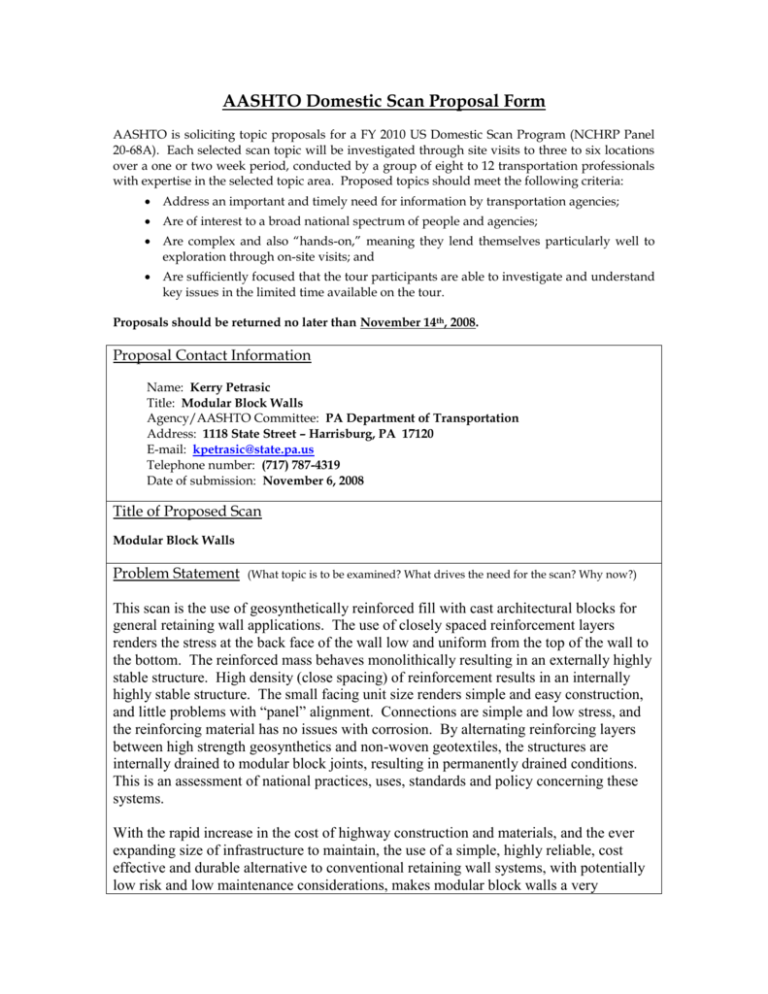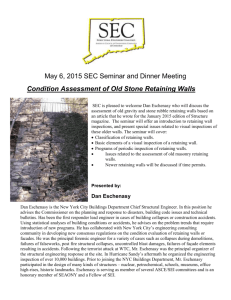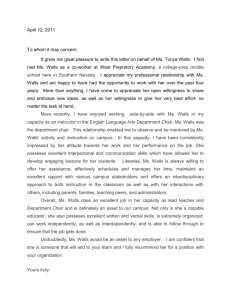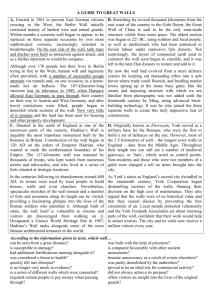Modular Block Walls
advertisement

AASHTO Domestic Scan Proposal Form AASHTO is soliciting topic proposals for a FY 2010 US Domestic Scan Program (NCHRP Panel 20-68A). Each selected scan topic will be investigated through site visits to three to six locations over a one or two week period, conducted by a group of eight to 12 transportation professionals with expertise in the selected topic area. Proposed topics should meet the following criteria: Address an important and timely need for information by transportation agencies; Are of interest to a broad national spectrum of people and agencies; Are complex and also “hands-on,” meaning they lend themselves particularly well to exploration through on-site visits; and Are sufficiently focused that the tour participants are able to investigate and understand key issues in the limited time available on the tour. Proposals should be returned no later than November 14th, 2008. Proposal Contact Information Name: Kerry Petrasic Title: Modular Block Walls Agency/AASHTO Committee: PA Department of Transportation Address: 1118 State Street – Harrisburg, PA 17120 E-mail: kpetrasic@state.pa.us Telephone number: (717) 787-4319 Date of submission: November 6, 2008 Title of Proposed Scan Modular Block Walls Problem Statement (What topic is to be examined? What drives the need for the scan? Why now?) This scan is the use of geosynthetically reinforced fill with cast architectural blocks for general retaining wall applications. The use of closely spaced reinforcement layers renders the stress at the back face of the wall low and uniform from the top of the wall to the bottom. The reinforced mass behaves monolithically resulting in an externally highly stable structure. High density (close spacing) of reinforcement results in an internally highly stable structure. The small facing unit size renders simple and easy construction, and little problems with “panel” alignment. Connections are simple and low stress, and the reinforcing material has no issues with corrosion. By alternating reinforcing layers between high strength geosynthetics and non-woven geotextiles, the structures are internally drained to modular block joints, resulting in permanently drained conditions. This is an assessment of national practices, uses, standards and policy concerning these systems. With the rapid increase in the cost of highway construction and materials, and the ever expanding size of infrastructure to maintain, the use of a simple, highly reliable, cost effective and durable alternative to conventional retaining wall systems, with potentially low risk and low maintenance considerations, makes modular block walls a very attractive alternative that should be closely investigated for standard use in highway design and construction. Scan Scope (What specific subject areas are to be examined? Which cities and states might be visited? Which agencies/organizations (including specific departments or types of staff if applicable)? Specific areas to be considered include: long term performance of modular block walls, short- and long-term cost-benefits of using these systems as compared to conventional concrete cantilever and MSE walls, conditions appropriate for the use of modular block walls, most efficient and effective materials for reinforcement and backfill, design methodologies and considerations, most efficient and effective construction techniques, and potential problems and constraints. State DOT’s, or other transportation related agencies and/or entities that have aggressively pursued the investigation and use of modular block walls should be targeted for the scan, as well as organizations and/or individuals involved in the research, development and implementation of the use of geosynthetic reinforced systems (e.g. GRI). Scan Objectives (What key information is to be gained? What information is to be shared after the scan? Who would the audience be for this information?) The key information to be determined and shared includes: 1) Long-term performance of modular block walls; 2) Cost analysis considering both short-term and long-term costs and cost versus benefits, especially as compared to conventional retaining wall systems; 3) Best design practices and requirements; 4) Best materials (geosynthetics and fill) to consider for use; 5) Constraints and conditions precluding or limiting the use of these types of structures; 6) Other benefits or challenges in using modular block walls; 7) Long term maintenance considerations; 8) Best construction practices. In short, do the initial cost and long-term performance and durability of modular block wall systems justify general use and application of this technology in retaining wall applications? The audience would be any organization or entity involved in the design, construction or maintenance or roadways, and other entities that routinely use, specify, design and/or construct retaining walls. Benefits Expected (Including potential impacts on current technology or procedures) The observed performance of these systems in non-highway applications has been impressive. Many of these applications are higher risk private ventures with very tight cost restrictions. Validation of the long-term performance and durability of these systems, documentation of cost and construction benefits versus conventional systems, and determination of best design and construction practices would help to set rational policy concerning the appropriate use of modular block walls. If the benefits have been found to be significant relative to conventional retaining wall systems, and long term performance and durability have been adequately demonstrated, considerable cost savings may be realized in implementing this technology as a standard practice.






